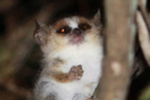
Flowers of a new species from the nettle family known only from caves, Pilea cavernicola, where it grows in very low light conditions. Photo by: Alex Monro.
The South China Karst region resembles a lost world with its stone forests and towering limestone formations that look like petrified skyscrapers. Standing at the edge of one of the region’s many vine-covered gorges, you could picture an apatosaurus lifting its head above the mist that blankets the gorge floor. Of course, that would be impossible, but what botanists recently found in the region was only slightly less surprising (to botanists). Near the back of a limestone cave, pink flowers bloomed on a newly discovered nettle that could survive on just a tiny fraction of the sunlight other plants receive. As Ian Malcolm in Jurassic Park said, “life will find a way.”
When botanist and nettle expert Alex Monro heard about the cave nettles from his Chinese colleague Wei Yi-Gang, he didn’t believe it.
“I thought that he was mis-translating a Chinese word into English,” Munro says. “When we stepped into our first cave, Yangzi cave, I was spell-bound. It had an eerie moonscape look to it and all I could see were clumps of plants in the nettle family growing in very dark condition.”
The botanists dubbed the new species Pilea cavernicola after the Latin for cave-dweller. In its subterranean lair, Pilea cavernicola only receives .04-2.78% the amount of full daylight. This feat of survival speaks to life’s tenacity and the endless versatility of evolution, but despite its hardiness, Pilea cavernicola is officially a vulnerable species according to the International Union for Conservation of Nature (IUCN). At present, scientists know the nettle from less than 200 mature specimens in only two locations—well within the IUCN’s criteria for vulnerability—but what is more disconcerting is the human threat Pilea cavernicola faces. Despite the Karst Region’s status as a UNESCO World Heritage Site, China continues to expand mining operations in the region. Farmers growing medicinal plants may also disturb the cave nettle by carving terraces right under its home.
But if the steep and unforgiving terrain of the Karst Region prove more vexing to developers, we may learn more about Pilea cavernicola‘s secrets of survival.

Botanists Wei Yi-Gang, Guangxi Institute of Botany, and Alex Monro, Royal Botanic Gardens Kew, standing within Yangzi cave with clumps of plants from the nettle family nearby. Photo by: Alex Monro.
CITATION: Monro AK, Wei YG, Chen CJ (2012) Three new species of Pilea (Urticaceae) from limestone karst in China. PhytoKeys 19: 51–66. doi: 10.3897/phytokeys.19.3968
Related articles
Scientists: bizarre mammal could still roam Australia

(01/03/2013) The continent of Australia is home to a wide variety of wonderfully weird mammals—kangaroos, wombats, and koalas among many others. But the re-discovery of a specimen over a hundred years old raises new hopes that Australia could harbor another wonderful mammal. Examining museum specimens collected in western Australia in 1901, contemporary mammalogist Kristofer Helgen discovered a western long-beaked echidna (Zaglossus bruijnii). The surprise: long-beaked echidnas were supposed to have gone extinct in Australia thousands of years ago.
Despite small brains, gray mouse lemurs use calls to avoid inbreeding

(12/03/2012) As a small-brained and largely solitary primate, the gray mouse lemur (Microcebus murinus) wasn’t supposed to have the capacity to distinguish the calls of its kin calls from other lemurs. However, a new study in BMC Ecology, finds that a female gray mouse lemur is able to determine the mating calls of its father, allowing it avoid inbreeding. The discovery challenges the long-held belief that only large-brained, highly social animal are capable of determining kin from calls.
New Guinea singing dog photographed in the wild for the first time
(12/03/2012) A rarely seen canine has been photographed in the wild, likely for the first time. Tom Hewitt, director of Adventure Alternative Borneo, photographed the New Guinea singing dog during a 12-day expedition up a remote mountain in Indonesian Papua. Very closely related to the Australian dingo, the New Guinea singing dog, so named for its unique vocalizations, has become hugely threatened by hybridization with domesticated dogs.
Long and thin with a big head: new snake adds diversity to a bizarre group (photo)
(11/28/2012) There’s no question that blunt-headed vine snakes are an odd lot: a thin body tapers into an even thinner neck which expands suddenly into a broad head with massive eyes. Until now only six species were recognized from this genus, known as Imantodes, but a new study in Zookeys describes a seventh species: Imantodes chocoensis from the Chocó Forests in northeastern Ecuador.
Rainforest fungi, plants fuel rainfall
(09/04/2012) Salt compounds released by fungi and plants in the Amazon rainforest have an important role in the formation of rain clouds, reports research published in the journal Science.
Forget-me-not: two new flowers discovered in New Zealand gravely endangered
(08/23/2012) New Zealand scientists have discovered two new species of forget-me-nots (flowers in the genus Mytosis), both of which are believed to be endangered. Discovered in Kahurangi National Park on the South Island, the new species highlight the diversity of the tiny flowers in New Zealand.